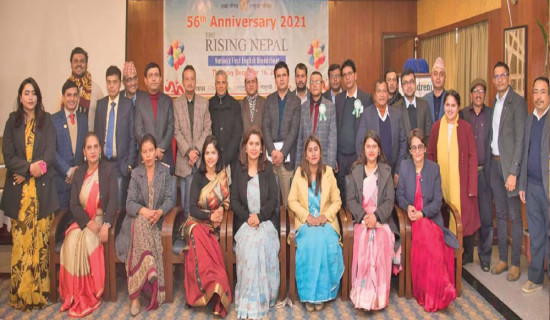- Wednesday, 17 December 2025
Towards A Gender Equal World
The Constitution of Nepal, 2015, ‘guarantees’ gender equality like several other laws of this land do in a typical organic fashion. Article 38 of our charter states that no physical, mental, sexual and psychological or any other type of violent act or exploitation shall be inflicted against women on the ground of religious, social, cultural traditions, practices or any other grounds. What’s more, clause 4 of the article grants women the right to participate in all bodies of the State on the basis of the principle of proportional inclusion; clause 5 grants the right to obtain special opportunities in education, health, employment and social security on the basis of positive discrimination, while clause 6 gives the spouse the equal right to property and family affairs.
In terms of ‘guaranteeing’ respect and dignity for women, our ancient scriptures do not lag much behind our contemporary laws. A pedestrian’s translation of an oft-quoted line from one of the holy books goes: Gods become happy where there’s respect for women. A popular Nepali adage likens the male and the female to Rathka dui pangra—the two wheels of a chariot.
Such ‘guarantees’ and sweet words aside, women and girls continue to lag far behind in every walk of national life, though there are notable exceptions, especially in politics and bureaucracy. After the promulgation of the federal republican constitution, the seventh charter for the country in a space of about eight decades, Nepal has got more women representatives in vital organs of the state like the executive, the federal parliament, state assemblies and at local levels, including a head of the state and a speaker. A few exceptions (mainly from upwardly mobile sections of the society) aside, things have not changed much in our country for women and girls in general.
A massive outmigration of men and boys in search of greener pastures has put heavier burdens on women and girls. These days also, women and girls remain unsafe in villages as well as in urban spaces, within and beyond the national boundaries. For them, educational and career opportunities are still few and far between and often fraught with risks. Against this backdrop, it will be relevant to have a look at the national gender equality policy, 2077. The policy lists changing social structure and mindset, increasing decisive role of women leaders, gender mainstreaming in the state's public policy, increasing access to justice by eliminating gender violence, eliminating harmful customs and traditions, internalisation and institutionalisation of gender issues at federal, provincial and local levels, balancing women's natural, professional and social roles, benefitting particular target groups, social transformation including gender equality by eliminating all kinds of discrimination against women and adolescents through development of gender-responsive governance as challenges (in bringing about gender equality). No wonder if reading the list leaves you breathless.
While a sizable number of women and girls stand shoulder to shoulder with men and boys in every walk of national life, lakhs remain in oblivion even as they continue to break ceilings made of materials far stronger than glass through significant contributions to their respective families,
communities, societies, professions, the country and the world.
Wrapping up this piece, violent incidents like the tragic loss of Prakriti Lamsal, a young and bright BTech Computer Science (third year) student at a university in Bhubaneshwar, come to mind. The 20-year-old student with boundless potential but without a credible support system lost her life abroad primarily because her repeated requests with relevant university authorities for protection from a perpetrator went unheard.
While independent media outlets on either side of the border continue to raise voices for a fair and independent probe into the case along with fellow students and other justice seekers from different walks of life, our ‘lawmakers’ and our government remain on mute mode, by and large, as daysdrag on.
The government in particular seems to be thinking that token measures taken initially—contacting university officials regarding the case, rushing officials from the Nepali Embassy in Delhi to Bhubaneswar (Odisha) for counselling Nepali students, who got beaten up and evicted from their hostel for seeking justice—are enough in this case. What’s more, student leaders of yore, who have become ‘youth leaders’ in their 50s, 60s or thereabouts, are far less vocal in this case than they should be, in sync with the hollow chambers of a ‘sovereign’ parliament.
These actors seem oblivious of the fact that failure to take up such cases sends a message that one can get away with anything against the citizens of a weak and instability-plagued Nepal, making them more vulnerable. As we celebrated International Women’s Day, once again, imagining a gender-equal world; a world free of bias, stereotypes, and discrimination; a world that's diverse, equitable, and inclusive; a world where difference is valued and celebrated.
This ‘imagination’ has made it quite clear that such an ideal world is nowhere near, especially for women and girls from underdeveloped countries like Nepal. Let this grim reminder encourage us to put our efforts together and march together towards a gender-equal world.
(The author is a freelancer.)

















